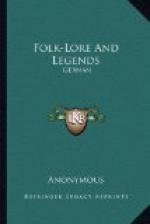Thus far my Lord Tarbat.
THE BOGLE.
This is a freakish spirit who delights rather to perplex and frighten mankind than either to serve or seriously hurt them. The Esprit Follet of the French, Shakespeare’s Puck, or Robin Goodfellow, and Shellycoat, a spirit who resides in the waters, and has given his name to many a rock and stone on the Scottish coast, belong to the class of bogles. One of Shellycoat’s pranks is thus narrated:—Two men in a very dark night, approaching the banks of the Ettrick, heard a doleful voice from its waves repeatedly exclaim, “Lost! lost!” They followed the sound, which seemed to be the voice of a drowning person, and, to their astonishment, found that it ascended the river; still they continued to follow the cry of the malicious sprite, and, arriving before dawn at the very sources of the river, the voice was now heard descending the opposite side of the mountain in which they arise. The fatigued and deluded travellers now relinquished the pursuit, and had no sooner done so, than they heard Shellycoat applauding, in loud bursts of laughter, his successful roguery.
DAOINE SHIE, OR THE MEN OF PEACE.
They are, though not absolutely malevolent, believed to be a peevish, repining, and envious race, who enjoy, in the subterranean recesses, a kind of shadowy splendour. The Highlanders are at all times unwilling to speak of them, but especially on Friday, when their influence is supposed to be particularly extensive. As they are supposed to be invisibly present, they are at all times to be spoken of with respect. The fairies of Scotland are represented as a diminutive race of beings, of a mixed or rather dubious nature, capricious in their dispositions, and mischievous in their resentment. They inhabit the interior of green hills, chiefly those of a conical form, in Gaelic termed Sighan, on which they lead their dances by moonlight, impressing upon the surface the marks of circles, which sometimes appear yellow and




